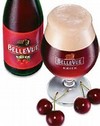Beer Flashcards
What are the two main steps for brewing beer?
- The brewer must derive the wort from malted grain
- Then the wort is fermented

How many ounces does a standard US longneck beer bottle contain?

12 oz
What is the wort?
Sugar-rich liquid derived from malted grains

What are the 4 main ingredients of beer?
- Water
- Yeast
- A start source (grains)
- Hops

malting process

- The grain is steeped in water for appx 2 days to promote germination of the grain
- Once it begins to germinate, or sprout, it is transferred to compartments with controlled temperature and moisture levels
- As the sprout grows to nearly an inch in length, the enzyme amylase is produced, which converts the starchy carbs to fermentable sugars
- This is then roasted to halt further growth

What is the cereal grain used for most beers?
Barley

What is green malt?

Unroasted malt

What two sugars are produced when malting grains?
Maltose and Dextrin
- both fermentable
What are the two subsets of beer?
Lagers and Ales
What is the major difference between a lager and an ale?
Lager
- wort is cooled to a lower temperature for fermentation
- uses bottom-fermenting yeasts
- often ferments slower and at lower temperatures
Ales
- use top fermenting yeasts
- ermentation is quick, usually less than a week
What is a cask ale?
Draught beers that are unpasteurized

What is the term for beers that are unfiltered and undergo partial fermentation in the bottle?
Bottle-conditioned

How are Lambic beers fermented?
- Spontaneously fermented in open-top containers
- With native wild yeasts, such as brettanomyces bruxellensis and brettanomyces lambiscus

Describe the characteristics of Lambic beers.
- Classic Lambics are almost vinous in character, distinctively sour
- Aged prior to release—often up to 3 years in cask

What is geuze?
- A style of lambic produced by mixing 1-year-old lambics with beers that have aged for 2 to 3 years
- The blend is then refermented with aged hops in the bottle, giving the beer its sparkle

What is a Kriek Lambic?
Lambic that has been refermented with sour Morello cherries

What is a Framboise Lambic?
Lambic that has been refermented with raspberries

Name two producers of lambic beers.
Lindemans
Cantillon

What is the typical alcohol content of beer?
4-6%
What is the service temperature of a lager?
48-52° F
What is the service temperature of light ales and draught bitter beers?
54-57° F
What is the service temperature of Trappist ales, lambics, stouts, brown ales and other powerful, strong beers?
At a cool room temperature
Name the different types of ales.
- Brown Ale
- Pale Ale
- Scotch Ale
- Mild Ale
- Burton Ale
- Old Ale
- Belgian Ale
- Trappist Ale
- Abbey Beer
- Stout
- Porter
Name the different types of lagers.
- Pilsner
- Bock (Doppelbock, Eisbock, Maibock)
- Märzen/Fest Beer
- Vienna Style
- Dortmunder
- Black/Schwartz
- Munich Helles
- Pale Lager
















